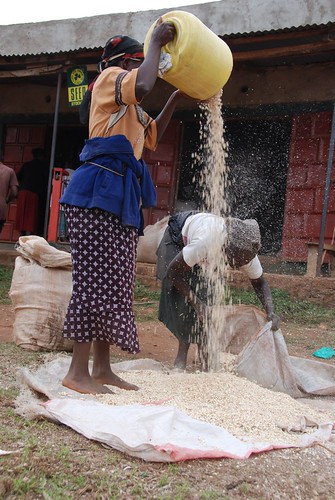How high are these prices, exactly? Literally every staple is costlier than when I arrived, and the #1 staple, white maize, is at 200% of last year’s price.
Changes in the cost of staple items since this time last year:
- maize: 2000 shillings/bag → 4000 shillings/bag (the school goes through 3 bags a week!)
- milk: 20 shillings/Litre → 40 shillings/Litre (not because there is a shortage, but because the producers went on strike so that they would get get a high enough price to be able to afford to buy maize to feed their families!)
- beans: 100 shillings/tin → 150 shillings/tin (the school goes through 4 tins a day)
- sugar: 100 shillings/kilo → 150 shillings/kilo
- bread: 40 shillings/loaf → 50 shillings/loaf
- cooking oil: 150 shillings/Litre → 200 shillings/Litre
- salt: 10 shillings/packet → 15 shillings/packet
- soap: 80 shillings/bar → 100 shillings/bar
- rice: 70 shillings/ kilo → 110 shillings/kilo
When I go to the market, it blows my mind how at least one of these prices rises every single day. Because the price of each staple is related to the price of the others, when one goes up the whole system seems to become a little more over stretched, ratcheting up prices to record levels.
Rising food costs combined with corrupt and obstructive governance and the worst drought in 60 years are creating a terrifying storm of humanitarian need all over the horn of Africa. In Kenya, there is a brewing but less noticed hunger crisis (and not only in the drought-affected northern areas). This CNN World article explains that prices in Kenya have risen faster than the global levels, and that Kenya’s problems have “been exacerbated by other factors, such as high fuel costs to transport food, the weak Kenyan shilling and maize export bans by neighboring countries” such as Tanzania, which recently imposed its own maize export ban to preserve domestic food security. In addition, because of the drought in the north, there is simply less food, and much of what little remains is being bought up to improve food security in the north.
With skyrocketing, unmanageable food prices, sometimes the price of feeding the family is foregoing education. In my last post, I explained Kenya’s summer-school like tradition of “tuition.” All around Enoosaen, however, I see children who should be in school playing in the streets or helping their parents with the small family restaurant or business, and several people have told me that this season in particular, exceptionally few families can afford to both feed their families and send their children to school with the the $2.00-$5.00 tuition school fee. It is not hard to understand, but it is a cruel reality that education loses out when struggling to provide basic survival needs.
And when the new semester starts on September 5th, school fees everywhere (especially at the all important boarding schools!) will be raised, and children whose parents already don’t care for education are becoming even more vulnerable to being taken out of school for lack of ability to pay. We too are feeling the costs at the Enkakenya Centre for Excellence, and Kakenya is trying to raise money specifically to cover the rising food costs, instead of passing the burden onto the families – we will try to do everything we can to keep this crisis from affecting our girls.
Posted By Charlotte Bourdillon
Posted Aug 13th, 2011




